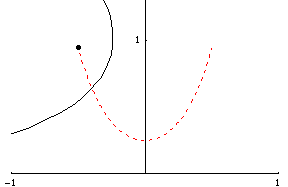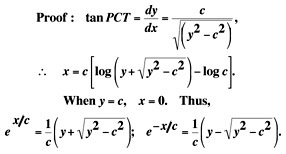|
For
the Catenary . . . .
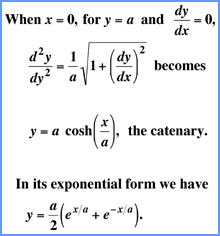
|
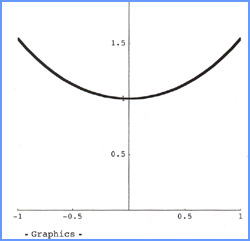
|
Definition:
The catenary is the form assumed by a
perfectly flexible inextensible chain of uniform density hanging from
two supports not in the same vertical line.
|
|
MATHEMATICA®Code
 The Catenary family of curves is easily
entered and modified in MATHEMATICA®
or on a graphing calculator.
The Catenary family of curves is easily
entered and modified in MATHEMATICA®
or on a graphing calculator.
There
are additonal interesting properties. . . .
Certain functions containing ex
and e-x
occur
sufficiently often in science and engineering to need a special
name, hyperbolic functions. They
are related to the equilateral hyperbola. Just as students learn
to relate the trig functions to the unit circle, the hyperbolic
functions have names related to the hyperbola as follows:
Hyperbolic sine of x:
Hyperbolic
cosine of x:
Hyperbolic
tangent of x:
|
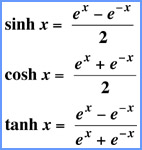
|
|
|
From Galileo's
Dialogo on
the Two New Sciences, 1638,
published after his trial. He was 74 years of age and nearly
blind when he wrote . . . .
On the Second Day,
Salviati speaking:
"Drive two nails into a wall at a convenient height and at the same
level; make the distance between these nails twice the width of
the rectangle upon which it is desired to trace the semiparabola.
Over these two nails hang a light chain of such length that the depth
of its sag (curve or sacca)
is equal to the length of the prism. This chain will assume the
form of a parabola,* so that if this form be marked by points on the
wall we shall have described a complete parabola which can be divided
into two equal parts by drawing a vertical line through a point midway
between the two nails. . . . Any ordinary mechanic will know how to do
it."
Galileo
Galilei, trans. by Henry Crew, 1950
*
It is now well known that the "hanging chain" curve is not a parabola
but our catenary. The equation of the catenary was first given 49
years after Galileo's death by James Bernoulli.
The name "catenary" is an Anglicized version of the Latin word catenaria first
used by Christiaan Huygens in a letter sent to Gottfried
Leibniz
in 1690. Both words are derived from the Latin noun catena meaning "chain."
|
A Brief Historical Sketch . . .
- Leonardo da Vinci sketched hanging chains in
his notebooks.
- Galileo mistook the shape to be that of a
parabola.
- Simon Stevin constructed problems dealing with
hanging ropes.
- René Descartes speculated on a letter
from Isaac Beeckman:
"a cord...afixed by nails...may
describe part of a conic section."- Jungius disproved the shape to
be a parabola (1669).
- Huygens, Leibniz and John Bernoulli all replied
to a challenge from Jacob Bernoulli posed in Acta Eruditorum to find the
catenary's actual shape (1690-1691).
- Jacob Bernoulli published their three solutions
in Acta within months (June,
1691). See below.
- David Gregory wrote a treatise on the catenary
(1697).
- Huygens proved to Mersenne that a hanging chain
would not be a parabola.
- Later, Leonhard Euler showed that a revolving
catenary will generate the only minimal surface of
revolution.
|
To underscore the
historical importance of the catenary,
we have selected the figures submitted by Gottfried Leibniz and
Christiaan Huygens to Jacob Bernoulli for publication in the widely
acclaimed Acta Eruditorum,
1691................................
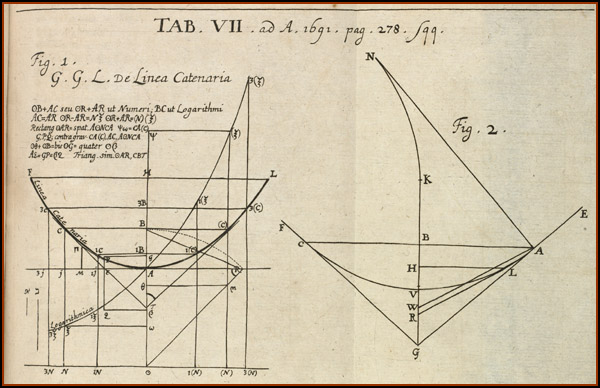
Reproduced with
permission from the Huntington Library, San Marino, California.
Leibniz's solution is on the left. Huygen's illustation is on the
right.
And from another classic . . .

|
The perpendicular TP from
the foot of the ordinate upon the tangent is of a constant length
c,
and therefore equal to OA, the
perpendicular from the origin on the tangent at the vertex. The
parameter of the curve is c in Carr’s
proof.
|
The
catenary
was Proposition #5273 in George S. Carr's
classic of classics, A Synopsis of Elementary Results in Pure
Mathematics, 1886. This book guided British
mathematics, especially in the
highly competitive Mathematical Tripos at Cambridge for almost
one-half century.
One of this books most ardent readers was Srinivasa Ramanujan who
mastered its contents as a young man in India, and later, in his early
30s, read the book as a source of comfort when on his death bed. |
And from another surprising source, a letter from Thomas Jefferson . . .
December
23, 1788
Paris, France
Thomas
Jefferson,
writing to another statesman, Thomas Paine,
regarding bridges to be built in his remote, young country:
|
". . .iron-men are
much better judges than we theorists. - You hesitate between the
catenary, and portion of a circle. I have lately received from
Italy a treatise on the equilibrium of arches by the Abbé
Mascheroni. It appears to be a very scientifical(sic) work. I have not yet
had
time to engage in it, but I find that the conclusions of his
demonstrations are that 'every part of the Catenary is in perfect
equilibrium.' . . .
To say another word of the Catenarian arch, without caring about
mathematical demonstrations, it's nature proves to be in equilibrio in
every point. It is the arch formed by a string fixed at both ends
and swaying loose in all the intermediate points. . . .
I am with sentiments
of sincere esteem & attachment, dear Sir, you friend and servant,
Th: Jefferson"
|
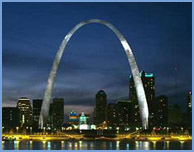
St. Louis Gateway Arch |
The equation of the curve that
approximates the Gateway Arch is

| The Arch
represents one of the largest
optical illusions ever created.
While it appears to be much taller than it is wide, the two distances
are
exactly the same at 630 feet. |
|
|
Useful
Links and Books
|
2015 Update: See
Philosophical Transactions A - Celebrating 350 years of
Philosophical Transactions: physical sciences papers (Theme issue
edited by Dave Garner).
C. R. Calladine, An amateur's contribution to the design of Telford's
Menai Suspension Bridge: a commentary on Gilbert (1826). On the mathematical theory of suspension
bridges. Philosophical Transactions A, Vol. 373, Issue
2039, April 13, 2015, pp. 7-11.
|
http://www-history.mcs.st-and.ac.uk/history/Curves/Catenary.html
|
http://mathworld.wolfram.com/Catenary.html
|
| Blackwell, Richard
J. (trans.), Christiaan Huygens' The Pendulum Clock or Geometrical
Demostrations Concerning the Motion of Pendula as Applied to Clocks,
The Iowa State Univ. Press, 1986. |
Boyd, Julian P.,
editor, The Papers of Thomas
Jefferson, Princeton University Press, vol. 14, 1958, pp. 372-4.
|
Bukowski, John, Christiaan Huygens and the Problem of the
Hanging Chain, The College Mathematics Journal, 39 (1),
January, 2008.
|
Carr, George
S., A Synopsis of Elementary
Results in Pure Mathematics, London and Cambridge, 1886.
The catenary was Proposition #5273 in this classic of classics that
guided British mathematics, especially in the highly competitive
Mathematical Tripos for one-half of a century.
One of the books most ardent readers was Srinivasa Ramanujan who
mastered its contents as a young man in India, and later, in his early
30s, read the book as a source of comfort when on his death bed.
|
| Galilei, Galileo,
Two New Sciences - Including Centers of Gravity and Force of Percussion,
trans. Stillman Drake, University of Wisconsin Press, 1974. |
Galilei, Galileo, Dialogues
Concerning Two New Sciences, trans. Henry Crew and Alfonso de
Salvio, Northwestern Univ. Press, 1950.
|
| Gray, Alfred, Modern
Differential Geometry of Curves and Surfaces with MATHEMATICA®, 2nd ed., CRC Press,
1998, pp. 55-57. |
Lockwood, E. H., A Book of
Curves, Cambridge University Press, 1961.
|
Swetz, Frank, John
Fauvel, Otto Bekken, Bengt Johansson and Victor Katz, Learn from
the MASTERS!, MAA, 1995, pp.123-130.
(See V. Frederick Rickey, "My Favorite Ways of Using
History in Teaching Calculus", in Swetz, et al.)
|
Ventress, Andy,
"Digital Images+Interactive Software=Enjoyable, Real Mathematics
Modeling," Mathematics Teacher,
101 (8), April 2008, pp. 568-572.
|
Yates, Robert, CURVES AND
THEIR PROPERTIES, The National Council of Teachers of Mathematics,
1952.
|

|

|
MATHEMATICA®
Code and animation contributed by
Dr. Gary Brookfield, CSULA.
|
|
|






